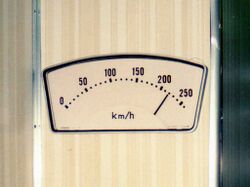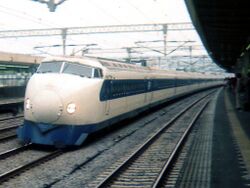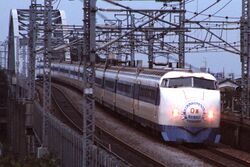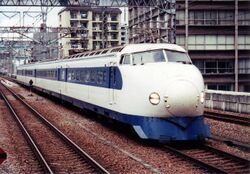0 Series Shinkansen
Topic: Engineering
 From HandWiki - Reading time: 10 min
From HandWiki - Reading time: 10 min
| 0 series | |
|---|---|
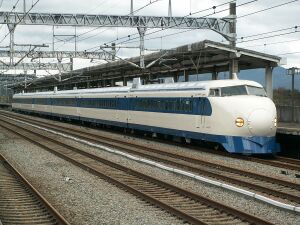 0 series 6-car set at Higashi-Hiroshima Station in April 2008 | |
| In service | 1 October 1964 – 14 December 2008 |
| Manufacturer | Hitachi, Kawasaki Sharyo, Kinki Sharyo, Kisha Seizo, Nippon Sharyo, Tokyu Car Corporation |
| Constructed | 1963–1986 |
| Refurbished | 1990–1998 |
| Scrapped | 2000–2008[citation needed] |
| Number built | 3,216 vehicles (201 sets)[clarification needed] |
| Number preserved | 27 vehicles ((As of September 2011)) |
| Successor | 300 series, 500 series, 700 series |
| Formation | 4, 6, 8, 12 or 16 cars per trainset |
| Capacity | 368–1,340[1] |
| Operator(s) | JNR (1964–1987) JR Central (1987–1999) JR West (1987–2008) |
| Depot(s) | Tokyo, Shin-Osaka, Hakata |
| Line(s) served | Tōkaidō Shinkansen(1964-1999), San'yō Shinkansen(1972-2008), Hakata-Minami Line(1990-2008) |
| Specifications | |
| Car body construction | Steel |
| Car length | 25 m (82 ft 1⁄4 in) (intermediate cars) 25.15 m (82 ft 6 1⁄8 in) (end cars) |
| Width | 3,383 mm (11 ft 1 1⁄4 in) |
| Height | 4,490 mm (14 ft 8 3⁄4 in) |
| Maximum speed | 210 km/h (130 mph) (1964–1986) 220 km/h (137 mph) (1986–2008) |
| Traction motors | Brushed DC motor, 185 kW (248 hp) each |
| Power output | 11,840 kW (15,878 hp) (16-car set)[2] |
| Transmission | Secondary-side tap changer drive |
| Acceleration | 1.0 km/(h⋅s) (0.62 mph/s) (1964–1992) 1.2 km/(h⋅s) (0.75 mph/s) (1992–2008) |
| Physics:Deceleration | 2.84 km/(h⋅s) (1.76 mph/s)s |
| Electric system(s) | 25 kV AC, 60 Hz, overhead catenary |
| Current collection method | PS 200 pantograph |
| Safety system(s) | ATC-1 |
| Track gauge | 1,435 mm (4 ft 8 1⁄2 in) standard gauge |
The 0 series (0系 Zero-kei) trains were the first generation Shinkansen trainsets built to run on Japan's Tōkaidō Shinkansen high-speed line which opened in 1964.[2] The last remaining trainsets were withdrawn in 2008 after 44 years of service.
History
The 0 series (which were not originally classified, as there was no need to distinguish classes of trainset until later[2]) entered service with the start of Tōkaidō Shinkansen operations in October 1964. These units were white with a blue stripe along the windows and another at the bottom of the car body, including the front pilot.
Unlike previous Japanese trains (except for some trains running on standard gauge sections on the Ou Main Line and Tohoku Main Line) the Tōkaidō Shinkansen and all subsequent Shinkansen lines are 1,435 mm (4 ft 8 1⁄2 in) standard gauge between the rails. The trains were powered by 25 kV AC electricity at 60 Hz with all axles of all cars powered by 185 kW (248 hp) traction motors, giving a 220 km/h (137 mph) operation top speed.
The original trains were introduced as 12-car sets, with some sets later lengthened to 16 cars. Later, shorter trains of six cars and even four cars were assembled for lesser duties. Production of 0 series units continued from 1963 until 1986.
Shinkansen sets are generally retired after fifteen to twenty years. The final remaining 0 series sets were six-car sets used on JR-West Kodama services on the San'yō Shinkansen between Shin-Ōsaka and Hakata, and on the Hakata-Minami Line until their retirement on 30 November 2008.
Following retirement from regular service, JR-West ran a number of special commemorative Hikari runs in December 2008.[3] Hikari 347, powered by set R61,[4] arrived at Hakata Station at 6:01 pm on 14 December 2008, bringing to an end the 44 years of service of the 0 series trains.
Set formations
Original 12-car H/K/N/R/S sets

The initial shinkansen fleet delivered for use on Hikari and Kodama services on the Tōkaidō Shinkansen from 1 October 1964 consisted of 30 12-car sets formed of 1st- and 2nd-batch cars. Six sets, H1 to H6, were built by Hitachi between April and August 1964, six sets, K1 to K6, were built by Kisha between July and September 1964, six sets, N1 to N6, were built by Nippon Sharyo between March and September 1964, six sets, R1 to R6, were built by Kawasaki Sharyo between July and September 1964, and six sets, S1 to S6, were built by Kinki Sharyo between April and August 1964.[5] These sets were allocated to Tokyo and Osaka depots.[6]
A further 10 12-car sets (H7/8, K7/8, N7/8, R7/8, S7/8) were delivered between April and July 1965, formed of 120 3rd-batch cars, five 4th-batch sets were delivered between June and July 1966, and five 5th-batch sets were delivered between October and November 1966.[6]
The original 12-car sets were formed as follows, with two first-class cars (type 15 and 16) and two buffet cars (type 35).[6]
| Car No. | 1 | 2 | 3 | 4 | 5 | 6 | 7 | 8 | 9 | 10 | 11 | 12 |
|---|---|---|---|---|---|---|---|---|---|---|---|---|
| Designation | Mc | M' | M | M' | MB | M' | MS | M'S | MB | M' | M | M'c |
| Numbering | 21 | 26 | 25 | 26-200 | 35 | 26-200 | 15 | 16 | 35 | 26 | 25 | 22 |
12-car H/K/N/R/S/T Kodama sets
A further 21 6th- to 9th-batch 12-car sets were delivered between 1967 and 1969 with only one first-class car (type 16) for use on Kodama services. The "T" sets were built by Tokyu Car Corporation.[6]
These sets were formed as follows.[6]
| Car No. | 1 | 2 | 3 | 4 | 5 | 6 | 7 | 8 | 9 | 10 | 11 | 12 |
|---|---|---|---|---|---|---|---|---|---|---|---|---|
| Designation | Mc | M' | M | M' | MB | M' | M | M'S | MB | M' | M | M'c |
| Numbering | 21 | 26-100 | 25-100 | 26-300 | 35-100 | 26-300 | 25-300 | 16 | 35-100 | 26-100 | 25-100 | 22 |
16-car H/K/N/R/S Hikari sets
The original 30 12-car sets were lengthened to 16 cars between December 1969 and February 1970 with the inclusion of new 10th-batch cars for Hikari services to handle the increased number of passengers travelling to and from Expo '70 in Osaka in 1970. From the opening of the San'yō Shinkansen in 1972, these sets were renumbered H1 to H30.[6]
| Car No. | 1 | 2 | 3 | 4 | 5 | 6 | 7 | 8 | 9 | 10 | 11 | 12 | 13 | 14 | 15 | 16 |
|---|---|---|---|---|---|---|---|---|---|---|---|---|---|---|---|---|
| Designation | Mc | M' | M | M' | MB | M' | M | M' | MS | M'S | MB | M' | M | M' | M | M'c |
| Numbering | 21 | 26 | 25 | 26-200 | 35 | 26-200 | 25-700 | 26-700 | 15 | 16 | 35 | 26 | 25-500 | 26-700 | 25 | 22 |
16-car K Kodama sets
Between 1972 and 1973, the earlier 12-car Kodama sets were lengthened to 16 cars with the inclusion of new 13th- and 15th-batch cars, and were renumbered K1 to K47.[6]
| Car No. | 1 | 2 | 3 | 4 | 5 | 6 | 7 | 8 | 9 | 10 | 11 | 12 | 13 | 14 | 15 | 16 |
|---|---|---|---|---|---|---|---|---|---|---|---|---|---|---|---|---|
| Designation | Mc | M' | M | M' | MK | M' | M | M' | M | M' | M | M'S | MB | M' | M | M'c |
| Numbering | 21 | 26 | 25 | 26-300 | 25-400 | 26-200 | 25-200 | 26-800 | 25-500 | 26-800 | 25-700 | 16 | 35 | 26 | 25 | 22 |
16-car H Hikari restaurant car sets
With the opening of the Sanyo Shinkansen extension to Hakata, the fleet of 16-car H Hikari sets was reformed and increased between 1973 and 1974 with the inclusion of new 16th- and 17th-batch cars, including new restaurant cars (type 36) in addition to the buffet car (type 35). The fleet as of 10 March 1975 consisted of 64 sets, numbered H1 to H64.[6]
| Car No. | 1 | 2 | 3 | 4 | 5 | 6 | 7 | 8 | 9 | 10 | 11 | 12 | 13 | 14 | 15 | 16 |
|---|---|---|---|---|---|---|---|---|---|---|---|---|---|---|---|---|
| Designation | Mc | M' | M | M' | M | M' | M | M'D | MB | M' | MS | M'S | M | M' | M | M'c |
| Numbering | 21 | 26 | 25 | 26-200 | 25-700 | 26-700 | 27 | 36 | 35 | 26-200 | 15 | 16 | 25-500 | 26 | 25 | 22 |
16-car NH Hikari sets
Between 1977 and 1980, 35 new 16-car NH sets were formed of −1000 subseries cars (batches 22 to 29) for Hikari services on the Tōkaidō Shinkansen and San'yō Shinkansen lines. The introduction of 100 series and later 300 series trains reduced the number of 0 series trains used on Hikari services, with 0 series Hikari services operated by JR Central ending in 1995. A small fleet was subsequently maintained by JR-West for use on additional holiday period Hikari services, with the last remaining unit, NH32, being disbanded in December 1999.
The NH sets had two Green (first class) cars and a restaurant car in addition to a buffet car, although use of the restaurant cars was discontinued from the mid-1990s.
| Car No. | 1 | 2 | 3 | 4 | 5 | 6 | 7 | 8 | 9 | 10 | 11 | 12 | 13 | 14 | 15 | 16 |
|---|---|---|---|---|---|---|---|---|---|---|---|---|---|---|---|---|
| Designation | Mc | M' | M | M' | M | M' | MA | M'D | MB | M' | MS | M'S | M | M' | M | M'c |
| Numbering | 21-1000 | 26-1000 | 25-1000 | 26-1200 | 25-700 | 26-700 | 27 | 36 | 35-1000 | 26-1200 | 15-1000 | 16-1000 | 25-500 | 26-1000 | 25-1000 | 22-1000 |
16-car YK sets
The 16-car YK sets were operated by JR Central on the all-stations Kodama services. These sets had upgraded reserved seat cars with 2+2 seating employing 100 series style seats, but only one Green car per 16-car set. Standard seating was 3+2 in standard class, and 2+2 in Green cars.
The fleet was operated by JR Central on the Tokaido Shinkansen until the last units were withdrawn on 18 September 1999. In the last two months of service, they ran with "Arigatō 0 Series" stickers on the front ends.
| Car No. | 1 | 2 | 3 | 4 | 5 | 6 | 7 | 8 | 9 | 10 | 11 | 12 | 13 | 14 | 15 | 16 |
|---|---|---|---|---|---|---|---|---|---|---|---|---|---|---|---|---|
| Designation | Mc | M' | M | M' | MB | M' | M | M'S | M | M' | M | M' | M | M' | M | M'c |
| Numbering | 21 | 26 | 25 | 26 | 37 | 26 | 25 | 16 | 25 | 26 | 25 | 26 | 25 | 26 | 25 | 22 |
Interior
12-car SK sets
These 12-car SK sets based at Hakata Depot were operated by JR-West on Sanyo Shinkansen West Hikari services between Shin-Osaka and Hakata. Sets were formed of upgraded 5000 and 7000 subseries vehicles with improved seating, and buffet cars were refurbished with a special seating area. All standard class cars had upgraded 2+2 seating. The sets were recognizable externally by the addition of an extra thin blue line below the windows (similar to 100 series) and by the large "West" decals near the doors. Some sets originally included specially converted cinema cars, but these were withdrawn in 1996. Following the end of the West Hikari services on 21 April 2000, the remaining SK units were reformed into new 6-car R60 sets to replace unrefurbished sets on Sanyo Shinkansen Kodama services.
| Car No. | 1 | 2 | 3 | 4 | 5 | 6 | 7 | 8 | 9 | 10 | 11 | 12 |
|---|---|---|---|---|---|---|---|---|---|---|---|---|
| Designation | Mc | M' | M | M' | MB | M' | M | M'S | M | M' | M | M'c |
| Numbering | 21 | 26 | 25 | 26 | 37 | 26 | 25 | 16 | 25 | 26 | 25 | 22 |
4-car Q sets
4-car Q sets were formed from March 1997 for use on Kodama shuttle services running between Hakata and Kokura/Hiroshima, and also for use on some Hakata-Minami Line duties. These sets had no Green car. The last remaining unit was withdrawn in September 2001.[6] Set Q3 remained as a static training set at Shin-Shimonoseki Station until 2009, when it was replaced by 100 Series set P2.[7]
| Car No. | 1 | 2 | 3 | 4 |
|---|---|---|---|---|
| Designation | Mc | M' | M | M'c |
| Numbering | 21 | 26 | 25 | 22 |
6-car R sets
The 6-car R units with no Green car were first formed in June 1985, and were used on JR-West Kodama services between Shin-Osaka and Hakata. They were also used to operate services on the short Hakata-Minami Line from Hakata Station.
The no. 3 cars of sets R2 and R24 were rebuilt as "Children's Saloons" with the former buffet counter area converted into a children's soft play area. These sets ran branded as "Family Hikari" during holiday periods. From March 1997 a refurbishment programme was commenced on the R sets, with new internal trim, rotating seats and new toilets/washing facilities. The refurbished units were recognisable externally by an extra thin blue line below the windows (as with West Hikari SK sets), and new "W" decals near the doors.
From April 2000, 6-car "WR" sets were created from former SK unit cars and renumbered in the R60 series. These retained the larger buffet area (disused) and 2+2 seating of the former West Hikari trains, and gradually replaced the remaining unrefurbished R sets. These units initially retained their "West Hikari" branding, but were gradually repainted into the new JR-West "Kodama" livery from May 2002. Initially scheduled to be withdrawn in 2006, the last three remaining sets (R61/R67/R68) remained in service until 30 November 2008. By June 2008 they had been repainted into their original ivory and blue livery with silver roofs.
| Car No. | 1 | 2 | 3 | 4 | 5 | 6 |
|---|---|---|---|---|---|---|
| Designation | Mc | M' | MB | M' | M | M'c |
| Numbering | 21 | 26 | 37 | 26 | 25 | 22 |
Interior
Preserved examples
A large number of former 0 series vehicles are preserved or stored in museums and various other locations around Japan. Outside Japan, the leading vehicle from a 0 series set is preserved at the National Railway Museum in York, England. It was donated to the museum by JR-West in 2001.[8]
| Vehicle number | Date built | Date withdrawn | Location | Remarks |
|---|---|---|---|---|
| 16-1 | March 1964 | March 1977 | Preserved at the Kyoto Railway Museum, which opened in April 2016. (Formerly displayed at the Modern Transportation Museum in Osaka .)[9] | Cars from pre-production "C" set H1.[10] |
| 21-1 | ||||
| 22-1 | ||||
| 35-1 | August 1964 | Cars from first production set H2. | ||
| 21-2 | July 1964 | The Railway Museum, Saitama | From original set H2. Moved from Osaka in August 2008. Exhibited from October 2009.[11] | |
| 22-2 | JR-West Staff Training Centre, Suita, Osaka | From original set H2. | ||
| 21-25 | April 1964 | March 1978 | The Railway Museum, Saitama | Cab section only. Originally displayed outside Tokyo Transport Museum. |
| 22-56 | August 1967 | February 1982 | "Wine no Kuni" hotel, Ikeda, Hokkaidō | Front third section only.[10] |
| 21-59 | March 1968 | Shintorimachi Park, Fuji, Shizuoka[10] | ||
| 21-73 | July 1969 | October 1984 | Shinkansen Park, Settsu, Osaka | [10] |
| 22-75 | August 1969 | March 1985 | Ome Railway Park, Ome, Tokyo | Repainted for short period into Tohoku ivory/green livery in late 1980s.[10] |
| 22-77 | September 1969 | March 1990 | Satsuki Kindergarten, Fukuoka | Used as a staff room and library.[10] |
| 36-84 | 1975 | SCMaglev and Railway Park, Nagoya | [12] | |
| 21-86 | December 1971 | November 1991 | ||
| 22-86 | JR Central Hamamatsu Works | [10] | ||
| 21-100 | September 1973 | October 1991 | Akishima City Library, Akishima, Tokyo | Used as library reading room.[10] |
| 21-141 | June 1976 | October 2000 | The Railway History Park in Saijo, Ehime Prefecture[13] | Former set H94, later R52. Front half only.[10] |
| 22-141 | National Railway Museum, York, England | A gift from JR West that was presented to the NRM in 2001. To date, this unit is the only Shinkansen of any series preserved at a museum outside Japan. | ||
| 22-1003 | November 1976 | November 1994 | Namikawa Railway Heritage Park, Kameoka, Kyoto | Cab section only.[10] |
| 21-2023 | January 1985 | June 1998 | J-TREC factory, Yokohama | Cab section only. Preserved at Sakuma Rail Park until November 2009. Moved to Tokyu Car from July 2010.[14] |
| 22-2029 | March 1986 | September 1999 | Nippon Sharyo Factory, Toyokawa, Aichi | [10] |
| 16-2034 | 1986 | SCMaglev and Railway Park, Nagoya | [12] | |
| 37-2523 | 1983 | |||
| 21-5035 (formerly 21-1032) | June 1978 | 10 March 2004 | Tainan HSR station, Tainan, Taiwan | Cab from former set R1. Used as structure gauging car during the construction of the Taiwan High Speed Rail until 2008. On display at Tainan HSR station from June, 2021.[15] |
| 22-7007 | – | December 2008 | Suita Yard, Osaka Prefecture | Cab from former set R68. On display inside Suita City Kento Library since 11 November 2020.[16] |
| 21-7008 (formerly 21-2026) | 1983 | December 2008 | Kawasaki Heavy Industries factory, Hyogo Prefecture | Car of last operational set, R61[17] |
| 21-7038 | – | – | Kawasaki Good Times World, within Kobe Maritime Museum | West Hikari livery. Front third section.[10] |
Gallery
See also
References
- . Japan: Neko Publishing. 2006.
- . Japan: JRR. December 2006. ISBN 978-4-88283-046-7.
- ↑ 日本機械学会, ed (1999). 成山堂書店. p. 34. ISBN 978-4-425-92321-2.
- ↑ 2.0 2.1 2.2 Semmens, Peter (1997). High Speed in Japan: Shinkansen - The World's Busiest High-speed Railway. Sheffield, UK: Platform 5 Publishing. pp. 12, 55. ISBN 1-872524-88-5.
- ↑ "Thank you Shinkansen Series 0- Special Website" (in ja). http://www.jr-odekake.net/navi/shinkansen/0kei/senko_yoyaku/.
- ↑ "Error: no
|title=specified when using {{Cite web}}". tv-asahi.co.jp. http://www.tv-asahi.co.jp/ann/news/web/soci_news14.html?now=20081215211232_300k. - ↑ Electric Trains for the New Tokaido Line Railway Gazette 5 February 1965 pages100-104
- ↑ 6.0 6.1 6.2 6.3 6.4 6.5 6.6 6.7 6.8 . Japan: JRR. March 2011. pp. 18–53. ISBN 978-4-330-19811-8.
- ↑ "車両の動き2008-2009". Japan Railfan Magazine (Japan: Koyusha Co., Ltd.) 49 (579): 74. July 2009.
- ↑ National Railway Museum based article on the acquisition of the donated 0 series
- ↑ (in ja)Japan Railfan Magazine (Japan: Koyusha Co., Ltd.) 56 (662): 60. June 2016.
- ↑ 10.00 10.01 10.02 10.03 10.04 10.05 10.06 10.07 10.08 10.09 10.10 10.11 . Japan: San-ei. 2009. ISBN 978-4-7796-0534-5.
- ↑ JR East press release: "鉄道博物館における0系新幹線車両の公開について" (8 June 2009). Retrieved on 8 June 2009. (in Japanese). Archived 10 June 2009.
- ↑ 12.0 12.1 Tetsudō Daiya Jōhō Magazine (Japan: Kōtsū Shimbun) 40 (324): 20–33. April 2011.
- ↑ Sasada, Masahiro (25 November 2014) (in ja). Tokyo, Japan: Ikaros Publications Ltd.. p. 124. ISBN 978-4863209282.
- ↑ 0系新幹線電車前頭部を保存します [0 Series Shinkansen Front Section Preserved] (PDF) (Press release) (in 日本語). Tokyu Car. 23 August 2010. Archived from the original (PDF) on 11 October 2010. Retrieved 24 August 2010.
- ↑ 陳政偉 (2020-09-22). "高鐵修復新幹線0系花魁車 110年第2季開放展示". 中央通訊社. https://www.cna.com.tw/news/ahel/202009220298.aspx. Retrieved 2021-05-22.
- ↑ "駅ホームに新幹線、実は図書館です...大阪・吹田で初代「0系」公開". Yomiuri Shimbun. 2020-10-17. https://www.yomiuri.co.jp/national/20201017-OYT1T50161/. Retrieved 2021-05-22.
- ↑ Japan Railfan Magazine (Japan: Koyusha Co., Ltd.) 49 (578): 171. June 2009.
External links
 |
 KSF
KSF
